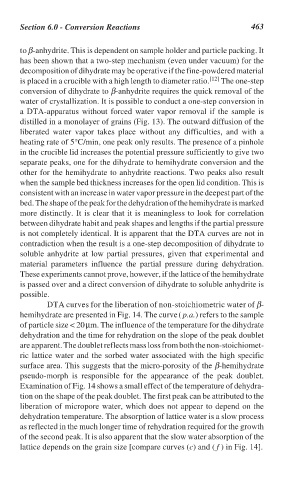Page 489 - Handbook of Thermal Analysis of Construction Materials
P. 489
Section 6.0 - Conversion Reactions 463
to β-anhydrite. This is dependent on sample holder and particle packing. It
has been shown that a two-step mechanism (even under vacuum) for the
decomposition of dihydrate may be operative if the fine-powdered material
is placed in a crucible with a high length to diameter ratio. [12] The one-step
conversion of dihydrate to β-anhydrite requires the quick removal of the
water of crystallization. It is possible to conduct a one-step conversion in
a DTA-apparatus without forced water vapor removal if the sample is
distilled in a monolayer of grains (Fig. 13). The outward diffusion of the
liberated water vapor takes place without any difficulties, and with a
heating rate of 5°C/min, one peak only results. The presence of a pinhole
in the crucible lid increases the potential pressure sufficiently to give two
separate peaks, one for the dihydrate to hemihydrate conversion and the
other for the hemihydrate to anhydrite reactions. Two peaks also result
when the sample bed thickness increases for the open lid condition. This is
consistent with an increase in water vapor pressure in the deepest part of the
bed. The shape of the peak for the dehydration of the hemihydrate is marked
more distinctly. It is clear that it is meaningless to look for correlation
between dihydrate habit and peak shapes and lengths if the partial pressure
is not completely identical. It is apparent that the DTA curves are not in
contradiction when the result is a one-step decomposition of dihydrate to
soluble anhydrite at low partial pressures, given that experimental and
material parameters influence the partial pressure during dehydration.
These experiments cannot prove, however, if the lattice of the hemihydrate
is passed over and a direct conversion of dihydrate to soluble anhydrite is
possible.
DTA curves for the liberation of non-stoichiometric water of β-
hemihydrate are presented in Fig. 14. The curve ( p.a.) refers to the sample
of particle size < 20 µm. The influence of the temperature for the dihydrate
dehydration and the time for rehydration on the slope of the peak doublet
are apparent. The doublet reflects mass loss from both the non-stoichiomet-
ric lattice water and the sorbed water associated with the high specific
surface area. This suggests that the micro-porosity of the β-hemihydrate
pseudo-morph is responsible for the appearance of the peak doublet.
Examination of Fig. 14 shows a small effect of the temperature of dehydra-
tion on the shape of the peak doublet. The first peak can be attributed to the
liberation of micropore water, which does not appear to depend on the
dehydration temperature. The absorption of lattice water is a slow process
as reflected in the much longer time of rehydration required for the growth
of the second peak. It is also apparent that the slow water absorption of the
lattice depends on the grain size [compare curves (c) and ( f ) in Fig. 14].

